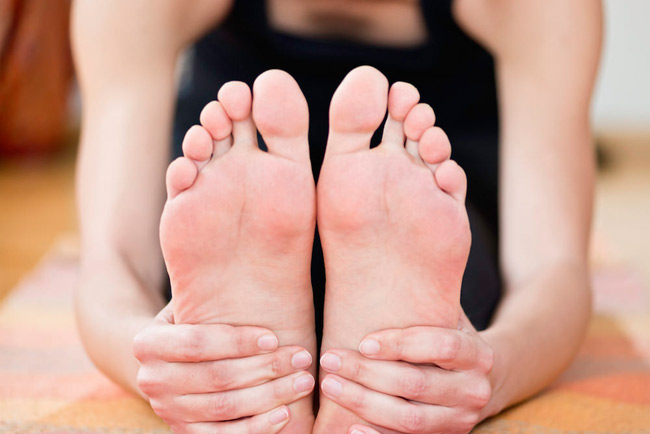
The absence of arch in the feet causing the soles to touch the ground is called a flat feet. An old term for flat feet is fallen arches. Having flat feet does not always cause pain or lead to other foot disorders. Flat feet can be rigid and inflexible and cause imbalance and problems in the ankles, legs, back, and bones and muscles as well.
For some flat foot can be painful and might result in imbalance. Shoes that do not fit or fail to support and protect the arch can lead to painful imbalances between the bones, muscles and ligaments of the foot.
Daily yoga practice can help strengthen the arches, foot and legs.
Virasana
Vira means a hero, warrior, champion. This sitting posture is done by keeping the knees together, spreading the feet and resting them by the side of the hips. The pose is good for meditation and pranayama.
- Kneel on the floor. Keep the knees together and spread the feet about 18 inches apart.
- Rest the buttocks on the floor, but not the body on the feet. The feet are kept by the side of the thighs, the inner side of each calf touching the outer side of its respective thigh. Keep the toes pointing back and touching the floor. Keep the wrists on the knees, palms facing up, and join the tips of the thumbs and forefingers. Keep the other fingers extended. Stretch the back erect.
- Stay in this position as long as you can, with deep breathing. Then rest the palms on the knees for a while.
- Then rest the palms on the knees for a while.
- Now interlock the fingers and stretch the arm straight over the head, palms up.
- Stay in this position for a minute with deep breathing.
- Exhale, release the finger lock, place the palms on the soles, bend forward and rest the chin on the knees.
- Stay in this position for a minute with normal breathing.
- Inhale, raise the trunk up, bring the feet forward and relax.
Utkatasana (chair pose)
A deep squat, Utkatasana immediately engages the strength of your legs, back, and ankles.
- From a standing position, step your feet hip-width apart so you feel grounded and connected to the width of your pelvis. On an exhalation, squat down from here as if to sit in a chair, keeping your heels on the floor.
- Explore the range of motion in your pelvis by bringing your hands to your hips, tilting your tailbone up (into a swayback) and then tucking it under. Notice the effect of both extremes. When you lift the tailbone, tipping the top of the pelvis forward, you jam your lower back. When the tailbone is tucked under, your abdomen is restricted.
- Now find the balance. Reach back and feel your sitting bones (those bony points at the base of your buttocks). Take your hands and sweep your sitting bones back as if dusting off your bottom葉his is the direction you want to move your sit bones. Keep releasing your sitting bones back while turning your tailbone down, so the sacrum moves forward into the body. You should feel a release in the lower back as your pelvis is stabilized (neither tucked nor swaybacked) and your sacrum broadens.
- On an inhalation, come up to standing and take a few cycles of breath to rest your thighs and integrate what you have experienced.
Vrksasana (Tree Pose)
Regular practice of this posture will help focus the mind and cultivate concentration (dharana).
- Stand with the feet together and the arms by your sides (see the tadasana.)
- Bend the right leg at the knee, raise the right thigh and bring the sole of the right foot as high up the inside of the left thigh as possible.
- Balancing on the left foot, raise both arms over the head keeping the elbows unbent and joining the palms together.
- Hold the posture while breathing gently through the nostrils for about 10 complete breaths.
- Lower the arms and right leg and return to the tad-asana, standing position with feet together and arms at the sides.
- Pause for a few moments and repeat on the opposite leg.
Ardha Chandrasana
- Stand in Tadasana. lace a block on its short side against the wall. Inhale, spread your feet 1m (3.5 ft) apart. Raise your arms to shoulder-level.
- Turn your right foot out to the right, parallel to the wall, and turn your left foot in, slightly to the right. Bend your right knee, and place the right palm on the block. Raise your left arm.
- Straighten your right leg. Raise your left leg, until it is parallel to the floor. Keep your left arm stretched up, in line with the right arm. The back of your left hand should touch the wall.
- Look up at your left thumb. keep your weight on the right foot, thigh, and hip, not on your right palm. Hold the pose for 20 seconds. Repeat the pose on the other side.
Practice Tadasana with lifted toes lifted on the floor. Another asana would be Frog pose (Bhekasana) although this pose is done lying down on the stomach.
Standing poses, one-legged poses, stretches and poses that elongate the leg, foot and body add strength and pull out muscles into a smooth position.
